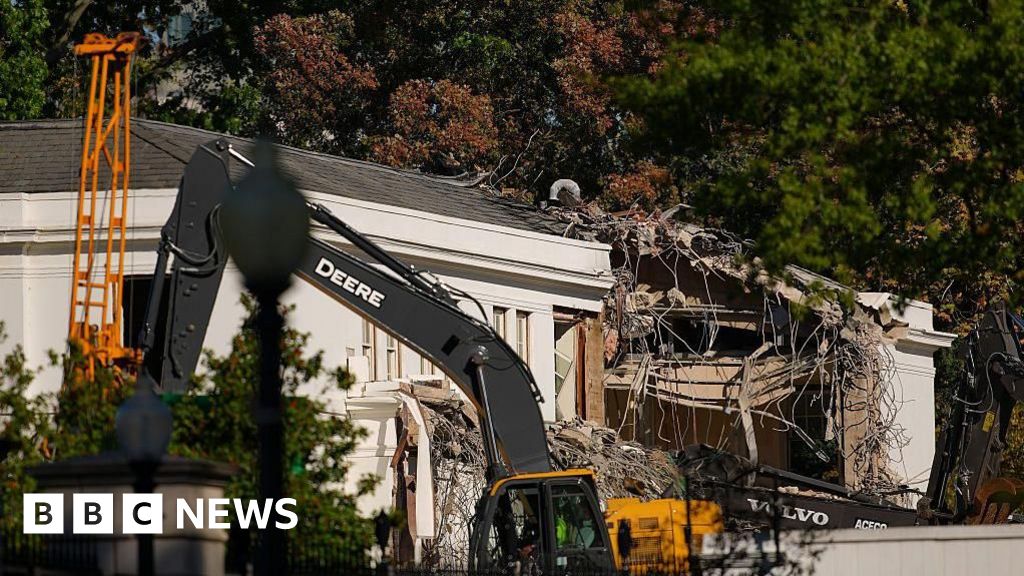Bernd Debusmann Jrat the White House
Watch: How Trump’s comments on East Wing demolition evolved
A full list revealing the wealthy donors and corporations paying for US President Donald Trump’s new $300m(£225m) White House ballroom has been released by the Trump administration.
Groundbreaking for the ornate 90,000 sq ft (8,360 sq m) project began on Monday, with excavators and construction workers tearing out portions of the East Wing.
The list includes dozens of companies, such as Amazon, Google and Meta, and several billionaire investors. The US president has said that he personally will pay for significant portions of its construction.
The funding model has sparked concern among some legal experts, who say it may amount to paying for access to the administration.
“I view this enormous ballroom as an ethics nightmare,” Richard Painter, a former chief ethics lawyer in the Bush White House between 2005 and 2007, told the BBC.
“It’s using access to the White House to raise money. I don’t like it,” he added. “These corporations all want something from the government.”
Some donors on the list attended a dinner at the White House on 15 October. They include Microsoft, Coinbase, Palantir, Lockheed Martin, Amazon and Google.
Also present and on the list was Shari and Edward Glazer, who, together with their siblings, own both the Tampa Bay Buccaneers and Manchester United.
The list also includes:
Altria Group IncAppleBooz Allen Hamilton IncCaterpillar IncComcast CorporationJ. Pepe and Emilia FanjulHard Rock InternationalHP IncMicron TechnologyNextEra Energy IncRippleReynolds AmericanT-MobileTether AmericaUnion Pacific RailroadAdelson Family FoundationStefan E BrodieBetty Wold Johnson FoundationCharles and Marissa CascarillaHarold HammBenjamin Leon JrThe Lutnick FamilyThe Laura & Isaac Perlmutter FoundationStephen A. SchwarzmannKonstantin SokolovKelly Loeffler and Jeff SprecherPaolo TiramaniCameron WinklevossTyler Winklevoss
A pledge form seen by CBS News, the BBC’s US partner, suggested that donors could be eligible for “recognition” for their contributions. While plans are still being finalised, that recognition could potentially take the form of names etched into the structure.
The White House had originally said that the gigantic structure would have a seated capacity of 650 people. This week, Trump said that it will be able to hold 999.
Court documents show that YouTube will pay $22m towards the project as part of a settlement with Trump regarding a lawsuit over the suspension of his account following the 6 January 2021 riot at the US Capitol.
But it is unclear how many of the rest of those in attendance may have pledged to donate, or how much.
Documents obtained by CBS indicate the donations will be handled by the Trust for the National Mall, a non-profit that works with the National Park Service and fundraises for projects on the Mall and at the White House.
At the event for potential donors, Trump said many of the attendees had been “really, really generous” and said that some had asked whether $25m was an appropriate donation.
“I said: I will take it,” Trump remarked.
Watch: Demolition begins on the East Wing of the White House
The White House has insisted there was nothing inappropriate about soliciting donations and that the ballroom will be used by future administrations. The renovation will not cost US taxpayers a cent, it has said.
Martin Mongiello, a former White House executive chef and Camp David general manager who has worked under seven administrations, told the BBC that the money paid to the ballroom “will eventually pay for itself and save costs”.
The tents sometimes set outside for events – which he described as “elbow to elbow” and “embarrassing”, often cost $1m or more, not including other ancillary costs associated with having large-scale events.
But Mr Painter suggested it could be considered a “pay-to-play scheme”, which has dogged previous White House administrations of both political parties.
In the 1990s, for example, then-President Bill Clinton came under scrutiny for allegedly selling overnight stays in the Lincoln Bedroom in exchange for campaign contributions.
More recently, Trump sought corporate sponsors for the annual White House Easter Egg Roll in April, which some said could amount to companies vying for the president’s attention.
Trump and administration officials have said that the new ballroom was a necessary renovation given the lack of large existing facilities to hold state dinners and other events. The White House often uses a tent on the South Lawn to fete foreign leaders and a larger guest list for a state dinner.
But the scale of the new ballroom, Mr Painter added, poses an “enormous temptation” to use the facility for political fundraising that was not the case before, even if presidents from both parties have invited supporters to events.
“The limited space 1761267608 means that not everyone gets a White House invitation,” he said. “In my view, that’s a good thing… The [current] size limits the ‘pay to play’ game, at least on White House premises.”
Proving any wrongdoing, however, is unlikely.
“You can’t prove a quid pro quo,” Mr Painter said. “But I think the Trump administration is pushing the envelope here.”

